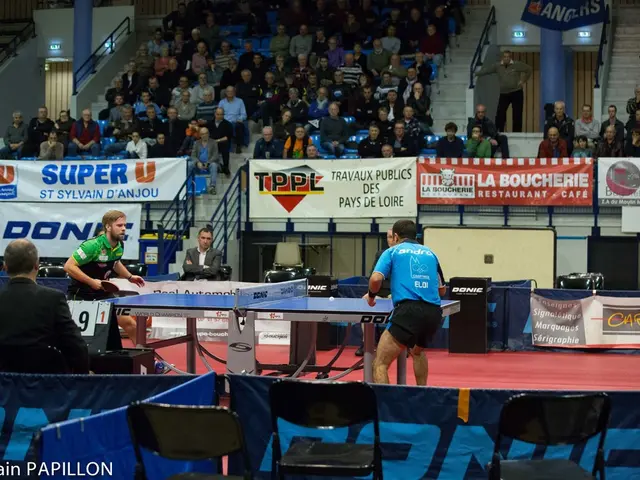Investigate: Uncovering Relevant Details
Suiting up the right cards can lead to some serious poker wins, and suited connectors are no exception. Sometimes these hands may not seem powerful at first, but when played correctly, they can become game-changers. In this pocket-friendly guide, we'll cover the advantages of playing suited connectors, the best strategies to make them winners, and common pitfalls to avoid.
So, what exactly are suited connectors in poker? They are a delightful combo of consecutive ranked cards from the same suit, such as 8♣ 9♣ or 10♠ J♠. These babies offer a one-of-a-kind advantage, owing to their potential to form strong, valuable hands like straights, flushes, or even elusive straight flushes. While suited connectors can truly turn a game around, they require some strategy to maximize their potential.
Not all cards with consecutive ranks and the same suit form suited connectors, though. A hand like 8♣ 6♣ is known as a "suited gapper," and unlike true suited connectors, these hands don't have much straight potential, making them a riskier choice overall.
But what makes suited connectors so dang cool is their flexibility and their ability to deliver winning combinations, particularly on favorable flops. However, if you're not strategic about it, they can also burn you fast if played recklessly or on unfavorable boards. Knowing when to play suited connectors and understanding the risks and rewards is essential to succeed with these versatile hands.
Which Suited Connectors Reign Supreme?
When it comes to hand rankings, the royal flush is usually the ultimate goal, but we're focusing on humbler heroes today - suited connectors. The best suited connectors are the ones with high-value pairs, such as J♥ Q♥, 10♠ J♠, and 9♦ 10♦. These babies give you a solid shot at strong straights and flushes, especially when played in later positions.
On the other hand, low suited connectors, like 3♣ 4♣, or 2♦ 3♦, usually don't have much value. While they can make a straight or a flush, these hands are often dominated by stronger flushes or straights. And let's not forget about our middle-of-the-road suited connectors, like 7♠ 8♠, which offer a nice balance between extremes, providing moderate potential without much risk compared to low connectors.
Taming Those Suited Connectors
Now that we've got a feel for what different suited connectors look like, let's dive deep into the strategies for playing them in real life (and online) poker games. Suited connectors can be powerful weapons when employed strategically. Here are four essential strategies to help you rake in the chips with suited connectors.
Hit Those High Notes
When you rock a pair of high-suited connectors like J♥ Q♥ or 10♠ 9♠, you're rollin' with better odds of forming high-value straights or flushes. That makes them a safe bet for aggressive play, especially when you're in the late positions. However, keep a keen eye out for situations where you might be ace-to-be-outranked by an opponent with an Ace-high flush, as that can turn a winning hand into a fouled one in flush-beatdown scenarios.
Let the Good Times Roll in Multi-player Pots
Suited connectors have a knack for shining in multiplayer pots. That's when multiple contributors build the pot, increasing the potential for some serious payback. When you hit a strong hand, like a flush, a straight, or a high draw, the return on investment can be substantial, especially against multiple opponents.
If you're only putting up a small commitment to see the flop, that's the perfect time for suited connectors. They're low-risk, high-reward plays that can pay off big time when the flop turns their spades and hearts into gold.
Choose Your Battles Wisely
When playing suited connectors, it's crucial to adjust your strategy to the table dynamics. Suited connectors thrive on loose tables where players don't tend to make aggressive preflop raises, providing better odds of seeing the flop at a reasonable price. But in tighter tables, the competition becomes fiercer, with fewer players joining the battle for the pots. That increases the pressure and makes the competition more intense.
Show 'em What You're Capable of
Suited connectors are perfect playthings for some sneaky cheating, especially when you miss the flop. But don't just bluff for the sake of it. Leverage strong draws as bluffing opportunities when you've got position, especially on boards with a favorable texture. That can help you put the pressure on your opponents and make them fold better hands or refrain from playing aggressively. And that means more chips in your stack, baby!
Putting Suited Connectors in Place Pre-Flop
Ready to unleash your suited connector powers pre-flop? Success with suited connectors requires skill and expert timing. Here are three quick tips to enhance your pre-flop strategy:
- Sit in Position: Position is everything when it comes to suited connectors. Sitting late (cutoff or button) allows you to gather intel on opponents' actions first, so you can make wiser decisions about whether to call, raise, or fold if the pot starts heating up.
- Go for It with High Connectors: When sporting high suited connectors, like J♦ Q♦ or 10♠ 9♠, you can afford to be assertive pre-flop by raising or calling in late position. These high rollers have better odds of forming strong hands, giving you the confidence to build the pot early.
- Balance Small Raises with Limps: If you're playing on a loose table, consider limping (just calling the big blind) with low or mid suited connectors to see the flop at a low cost. Alternatively, a small raise adds pressure while giving you control of the pot. Balance these tactics according to the table's dynamics.
So, should you raise pre-flop with suited connectors? Raising pre-flop with suited connectors can be a smart move, but it depends on your position and the strength of your connectors. Raising from a late position with high suited connectors can put the squeeze on opponents and give you the upper hand in controlling the pot. However, raising low suited connectors from an early position can backfire if you don't have enough pot odds or if the hand isn't strong enough.
Odds and Ends: Suited Connectors vs. Other Poker Hands
Suited connectors have their unique winning chances against various hands. Here's a look at some common matchups to help you understand the odds better:
- Pocket Pairs (e.g., AA): Suited connectors have less than a 60% chance to beat pocket pairs pre-flop. However, their draw potential comes into play on the board.
- Small Pairs (e.g., 22): Suited connectors have around a 65-66% chance to win pre-flop against small pairs. On the board, the outcomes will depend on the specific cards that surface.
- Suited Connectors vs. Suited Connectors: The odds will depend on the ranks of the connectors. Generally, higher ranked suited connectors have a higher chance of winning pre-flop.
Remember, the odds in poker can be deceptive, and the real action happens post-flop. So don't rely solely on pre-flop odds to determine your moves. It's all about using the one-of-a-kind power of suited connectors to your advantage once you hit the flop.
Suited Connectors Post-Flop: What Awaits You
Imagine yourself sitting pretty with a suited connector, like 8♣ 7♣, and the flop comes 6♣ 9♣ A♥. Suddenly, you're sneakin' your way towards a flush draw, a straight draw, and even the elusive straight flush. The potential to make sick stack-cracking moves is here, my friend.
Post-flop, suited connectors can either rally on favorable terrain or falter on unfavorable boards. That means they require swift adaptability to maximize their potential.
Avoiding the Pitfalls: Common Mistakes to Skip
Suited connectors can bring home the bacon, but they can also lead to serious wallet-pain if you don't know what you're doing. Here are some common blunders to keep on your radar:
- Overvaluing Hands Pre-Flop: It's easy to get carried away with high-ranked suited connectors like J♦ T♦. However, don't overlook the importance of position and pot odds when investing pre-flop. Sometimes, it pays to play conservative and wait for better opportunities.
- Chasing Weak Draws: Suited connectors offer lots of appealing draws, but it's essential to pick and choose your battles wisely. Remember, garbage draws often lead to big losses. Don't get too eager and try to hit that inside straight or open-ended straight when the odds aren't in your favor.
- Ignoring Higher Flush Risks: Even if you hit a flush with a suited connector, you can't be too cocky. Higher flush risks lurk around every corner, potentially spelling doom for your formerly-winning hand. Always be mindful of the board and the potential for an opponent to outdraw you.
By avoiding these common errors, you'll be well on your way to seeing the value in suited connectors and exploiting their unique advantages with confidence.
- Suited connectors, a combination of consecutive ranked cards from the same suit, offer a unique advantage in poker due to their potential to form strong hands like straights, flushes, or even straight flushes.
- High suited connectors, such as J♥ Q♥, 10♠ 9♠, give better odds of forming high-value straights or flushes, making them ideal for aggressive play in later positions.
- Suited connectors can be powerful weapons when employed strategically, and their flexible nature allows them to deliver winning combinations, particularly on favorable flops.
- The best suited connectors are the ones with high-value pairs, like J♥ Q♥, 10♠ 9♠, and 9♦ 10♦, as they offer a solid shot at strong straights and flushes.
- Bluffing is possible with suited connectors, especially when you miss the flop, but it should be done judiciously, leveraging strong draws as bluffing opportunities when position, especially on boards with a favorable texture.
- When evaluating gambling trends in casino-games, such as poker, the anticipation of the playability and potential gains of suited connectors should be considered, as they can provide a substantial return on investment in multi-player pots.




